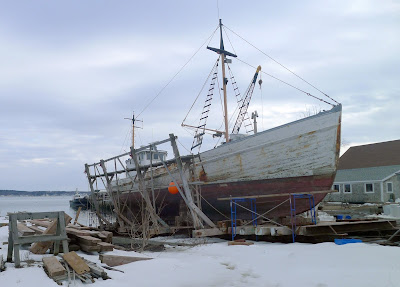I have many friends and I love them all, but painter guests are the best treat of all.
 |
| Autumn morning, by Carol L. Douglas |
Poppy Balser is teaching a workshop in St. Andrews, NB, this week. My house is just a hop past the border, so she came down at the end of last week to paint.
It wasn’t the Saxby Gale, but her arrival coincided with some fierce wind. It was so high that the sensible plein air painter stayed home. But we’d waited a long time for this painting opportunity, so we put on our warm clothes and headed out.
Last week I gave you a 40-mile circuit of painting locations in midcoast Maine. That was from memory. I can now tell you that it will take you a full day to drive it and take reference photos. Stopping to paint draws it out substantially. Poppy took about a thousand pictures. I took far fewer, but I live here.
| Under the Marshall Point Light, by Carol L. Douglas |
Marshall Point is windy enough on a normal day, and it was brutal on Friday. The only way to paint was to haul our stuff down the rocks and hunker in the shadow of the lighthouse. It’s not so far, but it is rocky going. “How’d you get down there?” a few intrepid tourists asked. The real question was how we were going to drag our gear back up.
On Saturday, we found another protected niche behind rocks on Beauchamp Point. It was a little bowl that reflected sunlight, and it seemed almost warm. We could take our time, at least until we decided, mid-afternoon, that we needed dinner.
| Sunset, by Carol L. Douglas |
The sun sets here at 5:30, but Rockport harbor is set within hills. The light fails even earlier. We always think of Nova Scotia as north, but it’s in fact almost due east. Digby, where Poppy lives, is straight across the Bay of Fundyfrom Grand Manan Island, which lies off the coast south of Lubec, ME. As the bird flies, Rockport is closer to Yarmouth, NS than it is to Boston, ME.
But Nova Scotia is on Atlantic Time, which means the sun sets an hour ‘later’ for Poppy. By Christmas, we’ll be experiencing sunset at 4 PM here. This is why I support efforts to put Maine on Atlantic Time.
 |
| Poppy in her painting-during-hunting-season cap. |
All too soon, it was Sunday and time for Poppy to leave. We solemnly agreed she would depart by noon in order to be over the Airline before dark and in St. Andrews by a reasonable hour. We only ran over by an hour, which has to be a record in promptness.
For our last paintings, I took her to an otherworldly, exposed, out-of-time place to paint: Clary Hill. It was blustery and 39°. Up we ambled, along the Land Trustpath, then up the lane to where three birders were silhouetted against the sky. They’re there every time I visit.
Poppy stopped and asked, “is that gun or a dump truck?”
 |
| Off Clary Hill, by Carol L. Douglas |
We counted back from deer season. Yes, it is bird season right now (Maine’s and the maritime provinces being almost the same). But the shots were coming from across the valley so we carried on.
A short while later, hunters passed us on the lane. Poppy was wearing an orange hat, so we weren’t panicking. We were eventually foxed, however, by the sound of guns behind us. It was just unnerving. But when we left, the birders were still at their posts, high on the hill.







